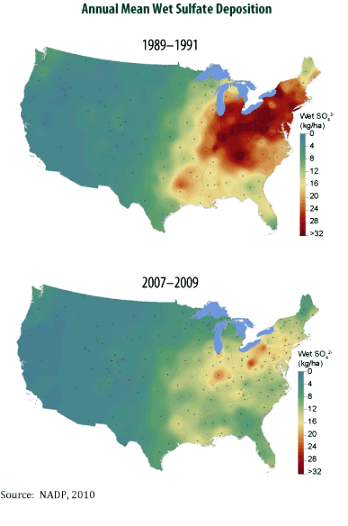“And they said it couldn’t be done …”
When it comes to cleaning up pollution, never underestimate the power of innovation.
Five years ago, the Environmental Protection Agency (EPA) faced a court deadline to regulate mercury pollution from power plants. Mercury is a potent neurotoxin that harms brain development in fetuses and growing children. But some in the utility industry argued that the technology was not available to achieve rigorous pollution reductions.
In 2005, EPA accepted those claims and issued a weak rule — one that was later thrown out by a federal appeals court.
EPA will take up the issue of the toxic pollution discharged from power plants soon — this coming March. Hopefully, they will keep in mind that industry pessimists who said it could not be done were wrong. Fast-moving innovation is delivering cost-effective mercury reductions right now, while growing America’s clean air technology industry. So this time around, EPA should not listen to the “sky is falling” claims — and should move ahead with rules that will protect Americans’ health.
Here’s more about the 2005 mercury rules:
Coal industry claims ACI technology isn’t feasible
Coal-fired power plants are the largest human-made source of mercury emissions in the United States. In 2004 and 2005, EPA considered several means to reduce power plant mercury emissions. The protective solution to implement the Clean Air Act would have required each coal-fired power plant to reduce mercury emissions by 90 percent through Activated Carbon Injection (ACI), a control technology that had been used in the waste-to-energy industry for many years and was already being successfully used by coal-fired power plants by the early 2000s.
But some members of the coal-fired utility industry claimed that ACI technology was many more years away from full-scale deployment, and projected that it would be 2018 before ACI could be feasibly installed at most power plants:
- A spokesman for the Electric Reliability Coordinating Council urged EPA to use “realistic assumptions about the current state of mercury control technology.” (Nesmith, Jeff, Rules on Mercury to Be Fine-Tuned, Atlanta Journal-Constitution, April 30, 2004, p. A6.)
- An official with Indianapolis Power & Light Company stated “If we can get a man to the moon, I’m sure we can get to 90 percent [mercury reduction] over time, just not now.” (Webber, Tammy, EPA Orders Industry to Cut Mercury by 70%, Indianapolis Star, March 16, 2005, p. A1.)
- EPA’s final rule mirrored industry claims: “Although EPA is optimistic that such controls may be available for use on some scale prior to 2018, it does not believe that such controls can be installed and operated on a national scale before that date.”
ACI technology proven feasible and cost-effective
Utility industry pessimists were wrong about the feasibility, scalability and cost of using ACI to reduce mercury pollution from coal-fired power plants. After EPA issued its weak rule (the one that was thrown out in court), many state and local governments stepped up to the plate and required power plants to protect public health from mercury pollution. Responding to the demand created by these state and local controls, companies have delivered cost-effective mercury control technology that is performing even better than hoped for.
As of June 2010, a large number of coal-fired power plants have ordered or installed mercury control technology — so many that, combined, they generate more than 62,000 megawatts of electricity, which is enough to serve more than 60 million American homes. Here’s a list of all those plants. Overwhelmingly, they have chosen to install ACI technology — the same kind that Clean Air Act pessimists dismissed five short years ago as unrealistic and impractical.
The Government Accountability Office reports that ACI systems have become even more effective at removing mercury from flue gas as they have been deployed in the electric utility industry. The GAO says, “Data from power plants shows that these boilers have achieved, on average, reductions in mercury emissions of about 90 percent” — and that applies to a variety of coal types burned in different boiler configurations. The GAO also says that this magnitude of reduction can be expected from the boiler configurations used at nearly three-fourths of the coal-fired utility boilers in the U.S.
Costs and benefits of ACI technology
ACI technology has turned out to be an efficient and affordable pollution control, and the cost of capturing mercury from power plants has dropped dramatically.
According to the Department of Energy’s National Energy Technology Laboratory, the 2008 cost to capture a pound of mercury was 1/6 the 1999 price. Advancements in the sorbents used to remove mercury have allowed ACI to be used for a wider range of coal qualities than was expected in 2005 (read more in this GAO report [PDF].) ACI systems now cost a fraction of other air pollution control devices.
“But there they go again …”
In spite of all the powerful evidence that mercury controls are available and highly cost-effective in protecting human health, some industry voices continue to argue against requiring them.
For instance, the U.S. Chamber of Commerce — ignoring the facts — still claims that mercury control solutions are not available.
Some in the utility industry persuaded EPA to bet against mercury control innovation the last time around, and as a consequence, EPA set policies that recklessly failed to protect human health. But state action and a nimble U.S. clean air technology industry has proven, yet again, that America can innovate to deliver the pollution reductions we need to protect our health and the health of future generations.
Now we need EPA to carry out the law to ensure all Americans are protected by clean air standards addressing toxic mercury from power plants.










